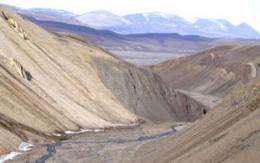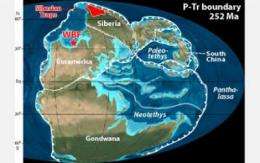Global extinction: Gradual doom is just as bad as abrupt

A painstakingly detailed investigation shows that mass extinctions need not be sudden events. The deadliest mass extinction of all took a long time to kill 90 percent of Earth's marine life, and it killed in stages, according to a newly published report.
Thomas J. Algeo, professor of geology at the University of Cincinnati, worked with 13 co-authors to produce a high-resolution look at the geology of a Permian-Triassic boundary section on Ellesmere Island in the Canadian Arctic. Their analysis, published Feb. 3 in the Geological Society of America Bulletin, provides strong evidence that Earth's biggest mass extinction phased in over hundreds of thousands of years.
About 252 million years ago, at the end of the Permian period, Earth almost became a lifeless planet. Around 90 percent of all living species disappeared then, in what scientists have called "The Great Dying." Algeo and colleagues have spent much of the past decade investigating the chemical evidence buried in rocks formed during this major extinction.
The world revealed by their research is horrific and alien: a devastated landscape, barren of vegetation and scarred by erosion from showers of acid rain, huge "dead zones" in the oceans, and runaway greenhouse warming leading to sizzling temperatures.

The evidence that Algeo and his colleagues are looking at points to massive volcanism in Siberia. A large portion of western Siberia reveals volcanic deposits up to five kilometers (three miles) thick, covering an area equivalent to the continental United States. And the lava flowed where it could most endanger life, through a large coal deposit.
"The eruption released lots of methane when it burned through the coal," he said. "Methane is 30 times more effective as a greenhouse gas than carbon dioxide. We're not sure how long the greenhouse effect lasted, but it seems to have been tens or hundreds of thousands of years."
A lot of the evidence ended up being washed into the ocean, and it is among fossilized marine deposits that Algeo and his colleagues look for it. Previous investigations have focused on deposits created by a now vanished ocean known as Tethys, a kind of precursor to the Indian Ocean. Those deposits, in South China particularly, record a sudden extinction at the end of the Permian.

"In shallow marine deposits, the latest Permian mass extinction was generally abrupt," Algeo said. "Based on such observations, it has been widely inferred that the extinction was a globally synchronous event."
Recent studies are starting to challenge that view.
Algeo and his co-authors focused on rock layers at West Blind Fiord on Ellesmere Island in the Canadian Arctic. That location, at the end of the Permian, would have been a lot closer to the Siberian volcanoes than sites in South China.
The Canadian sedimentary rock layers are 24 meters (almost 80 feet) thick and cross the Permian-Triassic boundary, including the latest Permian mass extinction horizon. The investigators looked at how the type of rock changed from the bottom to the top of the section. They looked at the chemistry of the rocks. They looked at the fossils contained in the rocks.
They discovered a total die-off of siliceous sponges about 100,000 years earlier than the marinemass extinction event recorded at Tethyan sites. Chemical clues, Algeo said, confirm that life on land was in crisis. Dying plants and eroding soil were being flushed into the ocean where the over-abundant nutrients led to a microbial feeding frenzy and the removal of oxygen – and life – from the late Permian ocean.
What appears to have happened, according to Algeo and his colleagues, is that the effects of early Siberian volcanic activity, such as toxic gases and ash, were confined to the northern latitudes. Only after the eruptions were in full swing did the effects reach the tropical latitudes of the Tethys Ocean.
Provided by University of Cincinnati


















